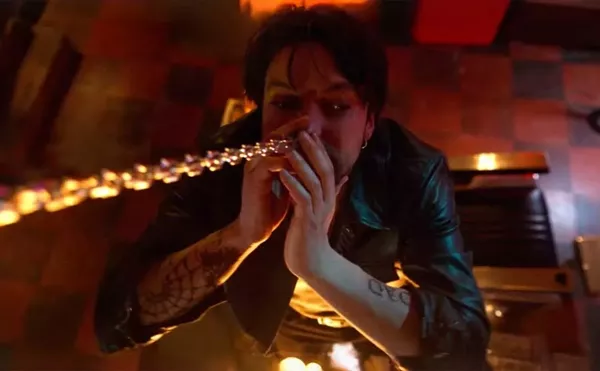
Audio By Carbonatix
[
{
"name": "GPT - Leaderboard - Inline - Content",
"component": "35519556",
"insertPoint": "5th",
"startingPoint": "3",
"requiredCountToDisplay": "3",
"maxInsertions": 100,
"adList": [
{
"adPreset": "LeaderboardInline"
}
]
}
]
Mary Fortuna has been a fixture in Detroit’s art community for more than 25 years. A Wayne State University graduate, Fortuna originally started working in drawing and printmaking. Since then, she’s created two bodies of work as a painter and a sort of puppet-maker. Both are on on view at ArtNxt, a Birmingham gallery that opened in October. We met Fortuna at the gallery to learn more about her art.
Metro Times: Some artists are content to find one thing they like doing and do it over and over again, but I'm always intrigued by artists who have more than one body of work, or more than one career. It seems you have that going on here with the puppets and the paintings. In your mind, are they separate?
Mary Fortuna: They are two very different things, but they relate to each other. There's a similar source of ideas, where the ideas come from similar places but express themselves in a different way. It's a completely different thing to work on the puppets and to work on the paintings. With the puppets, it's like Geppetto's little puppet shop going on — making heads and hands and feet and putting them all together. It's like a different headspace than sitting down to paint.
MT: What comes first, the paintings or the puppets?
Fortuna: That's really hard to pin down. With this show it had been a while since I had done puppets, and I had done some paintings recently. Frankly, it's a completely practical thing. I know I have a certain amount of time to get these things done; I know the clay is gonna take so long for it to dry, so I need to get a bunch of these going and bust them out. I do these in a group of 10 or a dozen because it's kind of the scale that it's easy to work at.
MT: Are the paintings more open ended?
Fortuna: You have to have a plan in mind for sculpture. And I've been making dolls for a while so I have a process for building them — that's why I keep on doing small bunches and not an assembly line. I've never wanted to be the person working for an art fair, and making 100 dolls at once and applying a formula. It's like a dance not to be formulaic about it, and that's why I only do a few at a time.
The paintings are much more of a "sit down and do it" thing. For some reason I can't stop putting snakes in everything. I don't think a ton about the meaning of images — things that look like they're a symbol for something turn into rabbit holes. Snakes turn up in mythology and origin stories all over the world. They are always doing particular things and have specific meanings.
MT: I had a girlfriend who had a visceral fear of snakes — even representations of snakes — and I always wondered if it was instinctual.
Fortuna: I think that is one thing humans have a really strong response to in general. There is a reason why snakes have sinister connotations. There is a reason why in folklore, the snake is the one that comes and brings you the news or brings you the knowledge or whatever. It's like you don't always trust the thing telling you all the secrets of the world. People make a quick connection to something that bites someone and kills them instantly. But you can't deny this attraction and beauty. There's something about this snake consciousness that is arresting.
MT: How long have you been in the snake phase?
Fortuna: In 2008, I started working on this piece called "The Tree of Life." The Tree of Life is something that's common in mythologies, and folklore, and creation stories all over the world. Every culture has some variation on this, and it's almost always guarded or protected by a snake or serpent. For example, in Chinese, it's dragon-like but it's still thought of as the serpent. The whole Adam and Eve story is just a variation on that story that's everywhere else. That's our core story — you wake up as an unadulterated human being somewhere, you look at the world and you think, "trees mean this, rocks mean this, snakes mean this," and you sort of create it all for yourself. It's kind of what my work is all about. God, that's not pretentious! That's what my work is all about — the meaning of the entire world! [Laughs.]
Dolls are the same too. Dolls, puppets — little representations of the human figure. I used to make dolls when I was a kid. Before I used to call myself an artist, I would make rag dolls for my friends' kids. It was hard for me to say, "It's OK to be an artist who takes herself seriously and to make dolls." The first time I showed any, I felt like I was on really shaky ground, like no one is going to take me seriously for the rest of my life because I'm that person who makes dolls.
But this is us confronting ourselves — we are making God in the image of ourselves. On one hand, it can be so trivial and so simple and straightforward, and one hand it goes as deep as it can get. I'm fully aware at how pretentious that sounds. I'm slightly concerned about it, but oh well. I'll get over it. [Laughs.]
Mary Fortuna: Mythos has been extended through Feb. 7 at ArtNxt, 2253 Cole St., Birmingham; 248-881-2612; artnxt.net.






